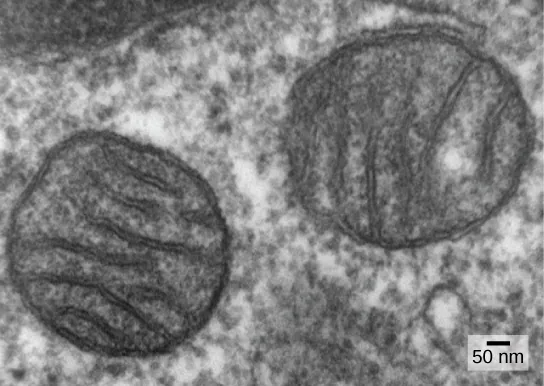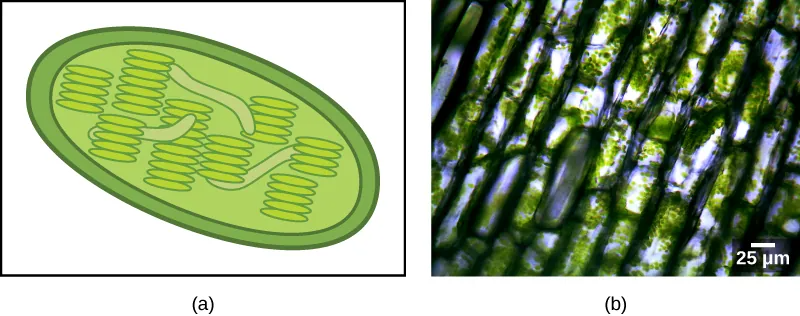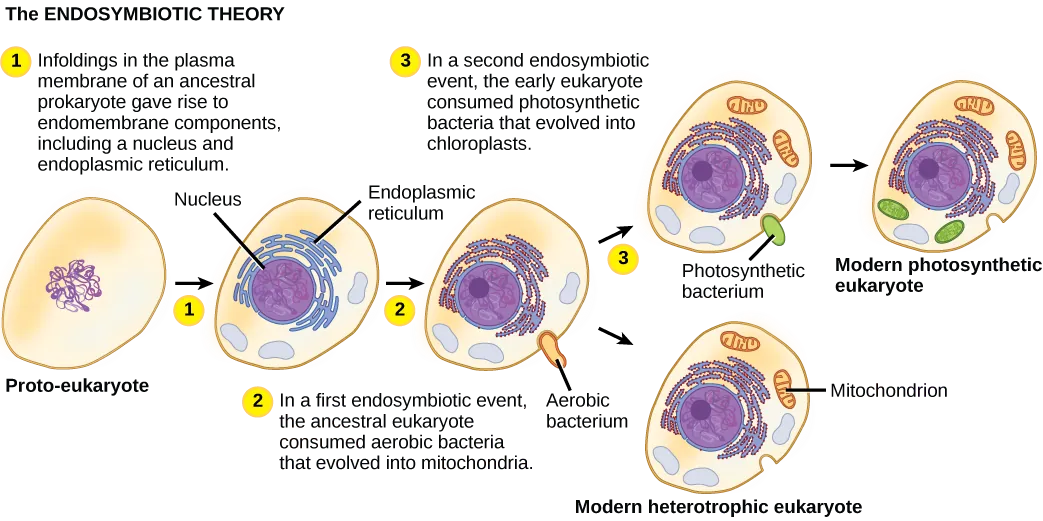23.1 Eukaryotic Origins
Learning Outcomes
- List the unifying characteristics of eukaryotes
- Describe what scientists know about the origins of eukaryotes based on the last common ancestor
- Explain the endosymbiotic theory
Organisms are classified into three domains: Archaea, Bacteria, and Eukarya. The first two lineages comprise all prokaryotic cells, and the third contains all eukaryotes. A very sparse fossil record prevents us from determining what the first members of each of these lineages looked like, so it is possible that all the events that led to the last common ancestor of extant eukaryotes will remain unknown. However, comparative biology of extant (living) organisms and the limited fossil record provide some insight into the evolution of Eukarya.
The earliest fossils found appear to be those of domain Bacteria, most likely cyanobacteria. They are about 3.5 to 3.8 billion years old and are recognizable because of their relatively complex structure and, for prokaryotes, relatively large cells. Most other prokaryotes have small cells, 1 or 2 µm in size, and would be difficult to pick out as fossils. Fossil stromatolites suggest that at least some prokaryotes lived in interactive communities, and evidence from the structure of living eukaryotic cells suggests that it was similar ancestral interactions that gave rise to the eukaryotes. Most living eukaryotes have cells measuring 10 µm or greater. Structures this size, which might be fossilized remains of early eukaryotes, appear in the geological record in deposits dating to about 2.1 billion years ago.
Characteristics of Eukaryotes
Data from these fossils, as well as from the study of living genomes, have led comparative biologists to conclude that living eukaryotes are all descendants of a single common ancestor. Mapping the characteristics found in all major groups of eukaryotes reveals that the following characteristics are present in at least some of the members of each major lineage, or during some part of their life cycle, and therefore must have been present in the last common ancestor.
- Cells with nuclei surrounded by a nuclear envelope with nuclear pores: This is the single characteristic that is both necessary and sufficient to define an organism as a eukaryote. All extant eukaryotes have cells with nuclei.
- Mitochondria: Most extant eukaryotes have “typical” mitochondria, although some eukaryotes have very reduced mitochondrial “remnants” and a few lack detectable mitochondria.
- Cytoskeleton of microtubules and microfilaments: Eukaryotic cells possess the structural and motility components called actin microfilaments and microtubules. All extant eukaryotes have these cytoskeletal elements.
- Flagella and cilia: Organelles associated with cell motility. Some extant eukaryotes lack flagella and/or cilia, but their presence in related lineages suggests that they are descended from ancestors that possessed these organelles.
- Chromosomes organized by histones: Each eukaryotic chromosome consists of a linear DNA molecule coiled around basic (alkaline) proteins called histones. The few eukaryotes with chromosomes lacking histones clearly evolved from ancestors that had them.
- Mitosis: A process of nuclear division in which replicated chromosomes are divided and separated using elements of the cytoskeleton. Mitosis is universally present in eukaryotes.
- Sexual reproduction: A meiotic process of nuclear division and genetic recombination unique to eukaryotes. During this process, diploid nuclei at one stage of the life cycle undergo meiosis to yield haploid nuclei, which subsequently fuse together (karyogamy) to create a diploid zygote nucleus.
- Cell walls: It might be reasonable to conclude that the last common ancestor could make cell walls during some stage of its life cycle, simple because cell walls were present in their prokaryote precursors. However, not enough is known about eukaryotes’ cell walls and their development to know how much homology exists between those of prokaryotes and eukaryotes. If the last common ancestor could make cell walls, it is clear that this ability must have been lost in many groups.
Endosymbiosis and the Evolution of Eukaryotes
Before we discuss the origins of eukaryotes, it is first important to understand that all extant eukaryotes are likely the descendants of a chimera-like organism that was a composite of a host cell and the cell(s) of an alpha-proteobacterium that “took up residence” inside it. This major theme in the origin of eukaryotes is known as endosymbiosis, one cell engulfing another such that the engulfed cell survives and both cells benefit. Over many generations, a symbiotic relationship can result in two organisms that depend on each other so completely that neither could survive on its own. Endosymbiotic events likely contributed to the origin of the last common ancestor of today’s eukaryotes and to later diversification in certain lineages of eukaryotes (Figure 23.5). Similar endosymbiotic associations are not uncommon in living eukaryotes. Before explaining this further, it is necessary to consider metabolism in prokaryotes.
Prokaryotic Metabolism
Many important metabolic processes arose in prokaryotes; however, some of these processes, such as nitrogen fixation, are never found in eukaryotes. The process of aerobic respiration is found in all major lineages of eukaryotes, and it is localized in the mitochondria. Aerobic respiration is also found in many lineages of prokaryotes, but it is not present in all of them, and a great deal of evidence suggests that such anaerobic prokaryotes never carried out aerobic respiration nor did their ancestors.
While today’s atmosphere is about 20 percent molecular oxygen (O2), geological evidence shows that it originally lacked O2. Without oxygen, aerobic respiration would not be expected, and living things would have relied on anaerobic respiration or the process of fermentation instead. At some point before about 3.8 billion years ago, some prokaryotes began using energy from sunlight to power anabolic processes that reduce carbon dioxide to form organic compounds. That is, they evolved the ability to photosynthesize. Hydrogen, derived from various sources, was “captured” using light-powered reactions to reduce fixed carbon dioxide in the Calvin cycle. The group of Gram-negative bacteria that gave rise to cyanobacteria used water as the hydrogen source and released O2 as a “waste” product.
Eventually, the amount of photosynthetic oxygen built up in some environments to levels that posed a risk to living organisms, since it can damage many organic compounds. Various metabolic processes evolved that protected organisms from oxygen, one of which, aerobic respiration, also generated high levels of ATP. It became widely present among prokaryotes, including in a free-living group we now call alpha-proteobacteria. Organisms that did not acquire aerobic respiration had to remain in oxygen-free environments. Originally, oxygen-rich environments were likely localized around places where cyanobacteria were abundant and active, but by about 2 billion years ago, geological evidence shows that oxygen was building up to higher concentrations in the atmosphere. Oxygen levels similar to today’s levels only arose within the last 700 million years.
Recall that the first fossils that we believe to be eukaryotes date to about 2 billion years old, so they seemed to have evolved and diversified rapidly as oxygen levels were increasing. Also, recall that all extant eukaryotes descended from an ancestor with mitochondria. These organelles were first observed by light microscopists in the late 1800s, where they appeared to be somewhat worm-shaped structures that seemed to be moving around in the cell. Some early observers suggested that they might be bacteria living inside host cells, but these hypotheses remained unknown or rejected in most scientific communities.
Endosymbiotic Theory
As cell biology developed in the twentieth century, it became clear that mitochondria were the organelles responsible for producing ATP using aerobic respiration, in which oxygen was the final electron acceptor. In the 1960s, American biologist Lynn Margulis of Boston University developed the endosymbiotic theory, which states that eukaryotes may have been a product of one cell engulfing another, one living within another, and coevolving over time until the separate cells were no longer recognizable as such and shared genetic control of a mutualistic metabolic pathway to produce ATP. In 1967, Margulis introduced new data to support her work on the theory and substantiated her findings through microbiological evidence. Although Margulis’s work initially was met with resistance, this basic component of this once-revolutionary hypothesis is now widely accepted, with work progressing on uncovering the steps involved in this evolutionary process and the key players involved.
While the metabolic organelles and genes responsible for many energy-harvesting processes appear to have had their origins in bacteria, our nuclear genes and the molecular machinery responsible for replication and expression appear to be more closely related to those found in the Archaea. Much remains to be clarified about how this relationship occurred; this continues to be an exciting field of discovery in biology. For instance, it is not known whether the endosymbiotic event that led to mitochondria occurred before or after the host cell had a nucleus. Such organisms would be among the extinct precursors of the last common ancestor of eukaryotes.
Mitochondria
One of the major features distinguishing prokaryotes from eukaryotes is the presence of mitochondria, or their reduced derivatives, in virtually all eukaryotic cells. Eukaryotic cells may contain anywhere from one to several thousand mitochondria, depending on the cell’s level of energy consumption, in humans being most abundant in the liver and skeletal muscles. Each mitochondrion measures 1 to 10 or greater micrometers in length and exists in the cell as an organelle that can be ovoid to worm-shaped to intricately branched (Figure 23.2). However, although they may have originated as free-living aerobic organisms, mitochondria can no longer survive and reproduce outside the cell.
Mitochondria have several features that suggest their relationship to alpha-proteobacteria (Figure 23.5). Alpha-proteobacteria are a large group of bacteria that includes species symbiotic with plants, disease organisms that can infect humans via ticks, and many free-living species that use light for energy. Mitochondria have their own genomes, with a circular chromosome stabilized by attachments to the inner membrane. Mitochondria also have special ribosomes and transfer RNAs that resemble these same components in prokaryotes. An intriguing feature of mitochondria is that many of them exhibit minor differences from the universal genetic code. However, many of the genes for respiratory proteins are now relocated in the nucleus. When these genes are compared to those of other organisms, they appear to be of alpha-proteobacterial origin. In some eukaryotic groups, such genes are found in the mitochondria, whereas in other groups, they are found in the nucleus. This has been interpreted as evidence that over evolutionary time, genes have been transferred from the endosymbiont chromosome to those of the host genome. This apparent “loss” of genes by the endosymbiont is probably one explanation why mitochondria cannot live without a host.
Another line of evidence supporting the idea that mitochondria were derived by endosymbiosis comes from the structure of the mitochondrian itself. Most mitochondria are shaped like alpha-proteobacteria and are surrounded by two membranes; the inner membrane is bacterial in nature whereas the outer membrane is eukaryotic in nature. This is exactly what one would expect if one membrane-bound organism was engulfed into a vacuole by another membrane-bound organism. The outer mitochondrial membrane was derived by the enclosing vesicle, while the inner membrane was derived from the plasma membrane of the endosymbiont. The mitochondrial inner membrane is extensive and involves substantial infoldings called cristae that resemble the textured, outer surface of alpha-proteobacteria. The matrix and inner membrane are rich with the enzymes necessary for aerobic respiration.

The third line of evidence comes from the production of new mitochondria. Mitochondria divide independently by a process that resembles binary fission in prokaryotes. Mitochondria arise only from previous mitochondria; they are not formed from scratch (de novo) by the eukaryotic cell. Mitochondria may fuse together; and they may be moved around inside the cell by interactions with the cytoskeleton. They reproduce within their enclosing cell and are distributed with the cytoplasm when a cell divides or two cells fuse. Therefore, although these organelles are highly integrated into the eukaryotic cell, they still reproduce as if they were independent organisms within the cell. However, their reproduction is synchronized with the activity and division of the cell. These features all support the theory that mitochondria were once free-living prokaryotes.
Some living eukaryotes are anaerobic and cannot survive in the presence of too much oxygen. However, a few appear to lack organelles that could be recognized as mitochondria. In the 1970s and on into the early 1990s, many biologists suggested that some of these eukaryotes were descended from ancestors whose lineages had diverged from the lineage of mitochondrion-containing eukaryotes before endosymbiosis occurred. Later findings suggest that reduced organelles are found in most, if not all, anaerobic eukaryotes, and that virtually all eukaryotes appear to carry some genes in their nuclei that are of mitochondrial origin.
In addition to the aerobic generation of ATP, mitochondria have several other metabolic functions. One of these functions is to generate clusters of iron and sulfur that are important cofactors of many enzymes. Such functions are often associated with the reduced mitochondrion-derived organelles of anaerobic eukaryotes. The protist Monocercomonoides, an inhabitant of vertebrate digestive tracts, appears to be an exception; it has no mitochondria and its genome contains neither genes derived from mitochondria nor nuclear genes related to mitochondrial maintenance. However, it is related to other protists with reduced mitochondria and probably represents an end-point in mitochondrial reduction. Although most biologists accept that the last common ancestor of eukaryotes had mitochondria, it appears that the complex relationship between mitochondria and their host cell continues to evolve.
Plastids
Some groups of eukaryotes are photosynthetic. Their cells contain, in addition to the standard eukaryotic organelles, another kind of organelle called a plastid. When such cells are carrying out photosynthesis, their plastids are rich in the pigment chlorophyll a and a range of other pigments, called accessory pigments, which are involved in harvesting energy from light. Photosynthetic plastids are called chloroplasts (Figure 23.3).

Like mitochondria, plastids appear to have an endosymbiotic origin. This hypothesis was also proposed and championed with the first direct evidence by Lynn Margulis. We now know that plastids are derived from cyanobacteria that lived inside the cells of an ancestral, aerobic, heterotrophic eukaryote. This is called primary endosymbiosis, and plastids of primary origin are surrounded by two membranes. However, the best evidence is that the acquisition of cyanobacterial endosymbionts has happened twice in the history of eukaryotes. In one case, the common ancestor of the major lineage/supergroup Archaeplastida took on a cyanobacterial endosymbiont; in the other, the ancestor of the small amoeboid rhizarian taxon, Paulinella, took on a different cyanobacterial endosymbiont. Almost all photosynthetic eukaryotes are descended from the first event, and only a couple of species are derived from the other, which in evolutionary terms, appears to be more recent.
There is also, as with the case of mitochondria, strong evidence that many of the genes of the endosymbiont were transferred to the nucleus. Plastids, like mitochondria, cannot live independently outside the host. In addition, like mitochondria, plastids are derived from the division of other plastids and never built from scratch. Researchers have suggested that the endosymbiotic event that led to Archaeplastida occurred 1 to 1.5 billion years ago, at least 5 hundred million years after the fossil record suggests that eukaryotes were present.

Link to Learning
Endosymbiotic theory
This video by Amoeba Sisters recaps the endosymbiotic theory.
engulfment of one cell within another such that the engulfed cell survives, and both cells benefit; the process responsible for the evolution of mitochondria and chloroplasts in eukaryotes
theory that states that eukaryotes may have been a product of one cell engulfing another, one living within another, and evolving over time until the separate cells were no longer recognizable as such
one of a group of related organelles in plant cells that are involved in the storage of starches, fats, proteins, and pigments

